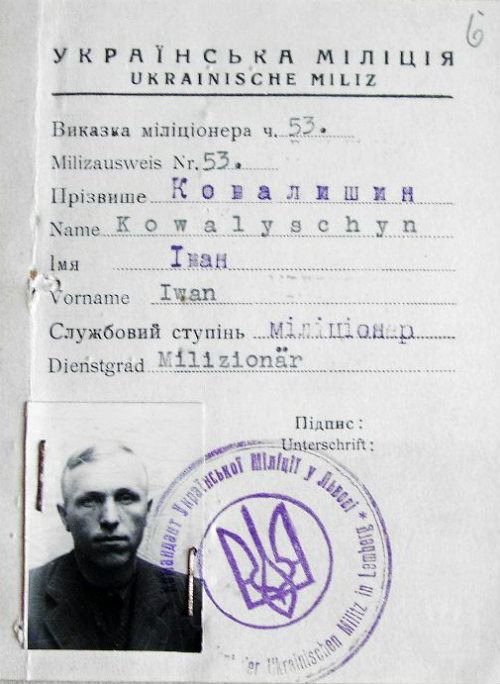 | ||
Active 23 June 1941 – November 1941 Country Selected cities and rural areas of General Government and Reichskommissariat Ukraine | ||
Ukrainian People's Militia or the Ukrainian National Militia (Ukrainian: Українська Народна Міліція), was a paramilitary formation created by the Organization of Ukrainian Nationalists (OUN) in the General Government territory of occupied Poland and later in the Reichskommissariat Ukraine during World War II. It was set up in the course of the 1941 Operation Barbarossa following the Nazi German attack on the Soviet positions in eastern Poland. The formation, created in June 1941, preceded the official founding of the Ukrainian Auxiliary Police in mid-August 1941 by Heinrich Himmler. There is conclusive historical evidence indicating that members of the Ukrainian Militia took a leading role in the 1941 Lviv pogroms, resulting in the massacre of 6,000 Polish Jews, after the German army reached Lwów (Lemberg) at the end of June in Soviet-occupied eastern Poland (now Lviv, Ukraine). Initially the Ukrainian militia acted independently, with the blessings of the SS, but later were limited to joint operations (Aktionen) with German units or otherwise functioned directly under the Nazi command.
Contents
The Ukrainian People's Militia was active in occupied territories behind the Wehrmacht lines, assisting the German Security Police and the Einsatzgruppen while the army kept advancing in the direction of Zhytomyr, Rivne and Kiev. Heinrich Himmler was appointed Chief of SS and Police for the Eastern Territories on 17 July 1941 and decreed the formation of the Schutzmannschaften from among the non-German auxiliaries. In mid-August he regrouped the indigenous militia which had sprung up under the military rule to form the core of the official Ukrainische Hilfspolizei. Before that, members of the Ukrainian militia in formerly Polish cities with sizeable Polish-Jewish presence compiled lists of targets for the branch offices of the KdS and assisted with the roundups (as in Stanisławów, Włodzimierz Wołyński, Łuck).[a] In Korosten, the Militia rounded up 238 Jews described as "a source of continuous unrest" and carried out the killings by themselves. In Sokal, on 30 June 1941 they arrested and executed 183 Jews dubbed "the commissars". Other locations followed.
By 7 August 1941 the stations of Ukrainian People's Militia were established in most areas conquered by the Wehrmacht including prominent formerly Polish cities under the Soviet reign of terror since 1939, such as Lviv (Lwów, Lemberg), Ternopil (Tarnopol), Stanislavov (Stanisławów), Lutsk (Łuck), Rivne, Yavoriv, Kamenetz-Podolsk, Drohobych (Drohobycz), Borislav, Dubno, Sambor, Kostopol, Sarny, Kozovyi, Zolochiv, Berezhany, Pidhaytsi, Kolomyya, Rava-Ruska, Obroshyno, Radekhiv, Gorodok, Kosovo, Terebovlia, Vyshnivtsi, Zbarazh, Zhytomyr and Fastov.
Ukrainian People's Militia instructions
The stated duty of the Ukrainian People's Militia was to maintain order in the newly occupied territories by defending the Ukrainian population from attacks by scattered remnants of the Red Army, killing organizers of Communist uprisings or Soviet parachutists caught behind the German lines, confiscating weapons, registering former Communist officials or specialists brought into western Ukraine from eastern regions, and shooting looters or those caught hiding firearms as well as collaborators with the Soviet state and the Soviet diversionaries. The regulations of the Ukrainian People's militia allowed Jews to join in but only under strict rules requiring them to wear yellow stars on their clothing. Poles and Russians were expressly prohibited from joining the force.
The OUN controlling the Ukrainian People' Militia were strongly opposed to the Soviet power structure that had been established in Galicia after the Soviet annexations, particularly the NKVD. The command sought to neutralize those particular elements that the OUN felt were critical to projecting Soviet power over Ukraine. Instructions issued in May 1941 by OUN in Distrikt Galizien were very specific about who the enemy was.
There are elements that give support to the Soviet regime and NKVD, which, with the creation of the new revolutionary power in Ukraine must be neutralized (i.e. liquidated; унешкідливлені). These elements are:
- The Muscovites (Russians) sent to Ukrainian lands in order to strengthen Moscow’s power in Ukraine
- The Jews, individually and as a national group
- The foreigners, mostly Asians, which Moscow uses to colonize Ukraine in order to turn the country into an ethnic chessboard
- The Poles on the West Ukrainian lands who have not given up the dream to build a Greater Poland at the expense of the Ukrainian lands, even if Greater Poland will became Red." End of quote.
The objectives of the People's Militia was to facilitate the eradication of the suspected members of the NKVD and the Communist Party including Soviet prosecutors or citizens who during the Soviet rule collaborated with them. All prominent non-Ukrainians were to be interred. The People's Militia – according to instructions – were advised to act in such way that "the army and the authorities of the ally" (i.e. the German Security Police and the Gestapo) would draw obvious benefits from the existence of the People's Militia."
State security department of the Militia
The Ukrainian People's Militia structure also included a "political department" – which is similar to the Gestapo (familiar to the OUN-R organization) – named as a "Secret State Police ".
On 25 June 1941 Yaroslav Stetsko wrote to Stepan Bandera that OUN had "formed a militia to remove the Jews". After the proclamation of the "Ukrainian Statehood with the leader of Stepan Bandera" in its government was created UDB (Department of the State Security). The 2 July 1941 Bandera's OUN People's militia – established by Yaroslav Stetsko group at Lemberg – was placed under the command of the Security police and Secret police.
If available, personnel of the Bandera's OUN People's militia were to use captured Soviet Army uniforms with a yellow-blue armband worn on the left sleeve. If such military clothing was not on hand, members were to wear a white armband stamped with the name People's Militia (Народна Міліція).
